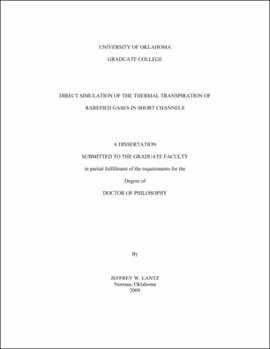| dc.contributor.advisor | Stalford, Harold | |
| dc.creator | Lantz, Jeffrey | |
| dc.date.accessioned | 2019-04-27T21:23:19Z | |
| dc.date.available | 2019-04-27T21:23:19Z | |
| dc.date.issued | 2009 | |
| dc.identifier | 99140993102042 | |
| dc.identifier.uri | https://hdl.handle.net/11244/318553 | |
| dc.description.abstract | Thermal transpiration (also referred to as thermal creep, thermal diffusion and thermomolecular flux) is the process by which a gas under the influence of a temperature gradient will flow through a channel from a cold region to a hotter one. This dissertation presents molecular simulations of thermally induced flow in the transition and free molecular regime using the probabilistic modeling technique referred to as Direct Simulation Monte Carlo (DSMC). We show how the thermomolecular flux can create a pressure increase which can be used as a pumping mechanism as well as present results of the net flux as a function of temperature, gas density, channel length, and accommodation coefficient. | |
| dc.description.abstract | This disseration begins with a presentation of the historical background which led up to kinetic gas theory and inspired Martin Knudsen and his pump idea. We describe the Knudsen pump idea in depth and outline the experimental progress and various Knudsen pump designs in the last 100 yeas. We then take a comprehensive look at the various types of micropumps and their pumping mechanisms. The last section of the review focuses specifically on gas phase pumps and the performance of existing Knudsen pumps. | |
| dc.description.abstract | Afterwards, we provide the basic kinetic theory of thermal transpiration and describe the work in that area in the previous century. We then present the modern methods for solving the thermal transpiration method including an analysis of the strengths and weaknesses of each method. We discuss at length the DSMC method, the errors involved in the method and the simulation parameters for my set of simulations. | |
| dc.description.abstract | Our DSMC simulations give the most complete DSMC results for both open and closed systems with the focus being on the thermomolecular flow through short channels throughout the transition and free molecular regimes. To our knowledge, our results are the first DSMC results to include both multiple pressure differences and temperature gradients and use those plots to derive maximum values for the flux, flowrate and pressure drop. We provide the first flowfield velocity profiles for both transition regime and free molecular regime flows as well as flux values for a variety of pressures differences at all Knudsen numbers. We also provide the pressure differences and pressure ratios when there is zero molecular flux along with flux data for pore arrays. | |
| dc.description.abstract | The results shown here are the first DSMC simulations looking at thermal transpiration for different aspect ratios and different tangential momentum accommodation coefficients for Knudsen numbers in the transition (0.1<Kn<10) and free molecular (Kn>10) regimes. We have run over 300 simulations where a single run takes anywhere from 12 hours to 7 days of computational time. For each flux or pressure difference data point, we ran several simulations at varying pressures using a single number density (Knudsen number) and temperature gradient. | |
| dc.description.abstract | Finally we provide four design scenarios which utilize the simulations results in various ways. We show how this phenomenon applies both to rarefied gases flowing through meso-sized channels as well as dense gases through micro/nano-channels. These designs show how the simulation results predict that a 1cm2 array of pores could achieve a maximum pressure difference of 7kPa and a maximum flowrate of over 1×108 sccm. The designs also emphasize the validity and usefulness of the DSMC simulations as well as provide the reader with a clearer understanding of the physics behind thermal transpiration and the potential performance of a Knudsen pump. | |
| dc.format.extent | 188 pages | |
| dc.format.medium | application.pdf | |
| dc.language | en_US | |
| dc.relation.requires | Adobe Acrobat Reader | |
| dc.subject | Rarefied gas dynamics | |
| dc.subject | Kinetic theory of gases | |
| dc.subject | Monte Carlo method | |
| dc.title | Direct Simulation of the Thermal Transpiration of Rarefied Gases in Short Channels | |
| dc.type | text | |
| dc.type | document | |
| dc.thesis.degree | Ph.D. | |
| ou.group | College of Engineering::School of Aerospace and Mechanical Engineering | |
